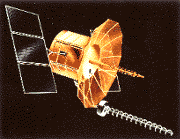FLTSATCOM
Fleet Satellite Communications
 The FLTSATCOM system provides worldwide,
high-priority UHF communications between naval aircraft, ships, submarines, and ground stations and between the Strategic Air Command and the national command authority network. Fully operational in January 1981, the FLTSATCOM constellation is being replaced by the UFO (UHF Follow-on) spacecraft.
The FLTSATCOM system provides worldwide,
high-priority UHF communications between naval aircraft, ships, submarines, and ground stations and between the Strategic Air Command and the national command authority network. Fully operational in January 1981, the FLTSATCOM constellation is being replaced by the UFO (UHF Follow-on) spacecraft.
Spacecraft
3-Axis stabilized. Two solar arrays (13.2 m across) generate >1400 W. Three hexagonal modules with aluminum structure. Hydrazine propulsion system for stationkeeping (120 kg fuel).
Payload
Twelve transponders with UHF/SHF uplink and UHF downlink. Large 4.9 meter diameter UHF receive antenna of silver-filled mesh. Offset mast UHF transmit antenna. Flights 6 and 7 carried experimental EHF transponder (20 W) to evaluate new ground terminals.
| Country of Origin | United States |
| Customer/User | USAF, Naval Space and Warfare Systems Command |
| Manufacturer(s) | TRW |
| Size | 2.5 m dia. x 1.3 m high |
| Orbit | Geosynchronous |
| Design Life | 7 years |
Launch Facts
| Name | Int'l Desig. | Date | Site | Vehicle | Orbit | Mass(kg) |
| Notes | ||||||
| FltSatCom 1 | 1978-016A | 2/9/78 | ESMC | Atlas Centaur | GEO | 1884 |
| Fleet Satellite Communications | ||||||
| FltSatCom 2 | 1979-038A | 5/4/79 | ESMC | Atlas Centaur | GEO | 1884 |
| FltSatCom 3 | 1980-004A | 1/18/80 | ESMC | Atlas Centaur | GEO | 1884 |
| FltSatCom 4 | 1980-087A | 10/31/80 | ESMC | Atlas Centaur | GEO | 1800 |
| FltSatCom 5 | 1981-073A | 8/6/81 | ESMC | Atlas Centaur | GEO | 1884 |
| FltSatCom 7 | 1986-096A | 12/5/86 | ESMC | Atlas Centaur | GEO | 2310 |
| FltSatCom 6 | none | 3/26/87 | ESMC | Atlas Centaur | FTO | 2300 |
| Destroyed by range safety | ||||||
| FltSatCom 8 | 1989-077A | 9/25/89 | ESMC | Atlas Centaur | GEO | 2310 |
| Last in series of 8 | ||||||
Information in The Mission and Spacecraft Library is provided without warranty or guarantee. USE AT YOUR OWN RISK.